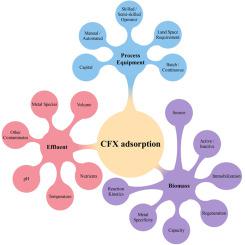Journal of Hazardous Materials ( IF 12.2 ) Pub Date : 2021-05-08 , DOI: 10.1016/j.jhazmat.2021.126040 Efaq Ali Noman 1 , Adel Al-Gheethi 2 , Radin Maya Saphira Radin Mohamed 2 , Balkis A Talip 3 , Md Sohrab Hossain 4 , Wahid Ali Hamood Altowayti 2 , Norli Ismail 4

|
In this article, the removal of cephalexin (CFX) antibiotic from non-clinical environment is reviewed. Adsorption and photocatalytic degradation techniques are widely used to remove CFX from waters and wastewaters, the combination of these methods is becoming more common for CFX removal. The treatment methods of CFX has not been reviewed before, the present article aim is to organize the scattered available information regarding sustainable approaches for CFX removal from non-clinical environment. These include adsorption by nanoparticles, bacterial biomass, biodegradation by bacterial enzymes and the photocatalysis using different catalysts and Photo-Fenton photocatalysis. The metal-organic frameworks (MOFs) appeared to have high potential for CFX degradation. It is evident from the recently papers reviewed that the effective methods could be used in place of commercial activated carbon. The widespread uses of photocatalytic degradation for CFX remediation are strongly recommended due to their engineering applicability, technical feasibility, and high effectiveness. The adsorption capacity of the CFX is ranging from 7 mg CFX g−1 of activated carbon nanoparticles to 1667 mg CFX g−1 of Nano-zero-valent iron from Nettle. In contrast, the photo-degradation was 45% using Photo-Fenton while has increased to 100% using heterogeneous photoelectro-Fenton (HPEF) with UVA light using chalcopyrite catalyst.
中文翻译:

从非临床环境中去除头孢氨苄抗生素的可持续方法:严格审查
在本文中,综述了从非临床环境中去除头孢氨苄(CFX)抗生素的情况。吸附和光催化降解技术被广泛用于从水和废水中去除CFX,这些方法的结合对于CFX去除变得越来越普遍。CFX的治疗方法以前尚未进行过审查,本文的目的是组织有关从非临床环境中去除CFX的可持续方法的分散的可用信息。这些包括纳米颗粒的吸附,细菌生物质,细菌酶的生物降解以及使用不同催化剂的光催化和Photo-Fenton光催化。金属有机框架(MOF)似乎具有CFX降解的高潜力。从最近的综述中可以明显看出,可以使用有效方法代替商业活性炭。强烈建议将光催化降解技术广泛用于CFX修复,因为它们的工程适用性,技术可行性和高效性。CFX的吸附容量为7 mg CFX g活性炭纳米粒子-1对1667 mg CFX g -1来自荨麻的纳米零价铁。相反,使用光-Fenton的光降解为45%,而使用黄铜矿催化剂使用UVA光的非均质光电子-Fenton(HPEF)的光降解增加到100%。











































 京公网安备 11010802027423号
京公网安备 11010802027423号